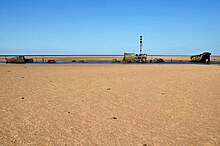|
Brancaster
Brancaster is a village and civil parish on the north coast of the English county Norfolk. The civil parish of Brancaster comprises Brancaster itself, together with Brancaster Staithe and Burnham Deepdale. The three villages form a more or less continuous settlement along the A149 at the edge of the Brancaster Manor marshland and the Scolt Head Island National Nature Reserve. The villages are located about 3 miles (4.8 km) west of Burnham Market, 22 miles (35 km) north of the town of King's Lynn and 31 miles (50 km) north-west of the city of Norwich.[1] The civil parish has an area of 8.27 square miles (21.4 km2) and in the 2011 census had a population of 797 in 406 households. For the purposes of local government, the parish falls within the district of King's Lynn and West Norfolk.[2] In 2016, Janet Lake, the clerk to Brancaster Parish Council, reached 50 years of service in the post.[2] The village's name means "Roman site of Branodunum", where the original Romano-British name may be preserved in the first element. The name is from British bran(n)o, "crow/raven" possibly used as a personal name, and duno-, "fortification". Alternatively, perhaps, "broomy Roman site". Geography and geologyA petrified forest can be seen on the foreshore near Brancaster at low tide. It is about three-quarters of a mile west of the golf clubhouse and consists of material similar to compacted peat or brown coal (lignite). Remains also wash ashore after storms and can be found along the high-tide line. The material resembles black rubber but can be broken easily to reveal plant remains inside. GovernanceAn electoral ward in the same name exists. This ward had a population at the 2011 census of 1,293.[3] Branodunum – Roman settlementThere was a Roman fort and settlement here named Branodunum to the east of the modern village. The Saxon Shore fort (and the related civilian settlement, much of which was destroyed during the construction of a locally opposed housing development in the 1970s) is visible only as grass-covered mounds and remains mainly unexcavated. Shipwreck on the beach   The wreck that used to be visible at low tide but has now been almost completely covered by the westerly drifting sand was the 1021grt coaster SS Vina which was used for target practice by the RAF before accidentally sinking in 1944. The Vina was built at Leith by Ramage & Ferguson in 1894 and was registered at Grangemouth. She was a coast-hugging general cargo ship which would have worked the crossings between the east coast of England and through to the Baltic states. As she neared the end of her useful seagoing life in 1940, Vina was requisitioned as a naval vessel for wartime use as a blockship, carrying a crew of 12. With Great Yarmouth being a strategic port on the east coast, the ultimate fate for the ship would have been to have had her hold filled with concrete and explosives and she would have been sunk at the harbour mouth, blocking entry in the event of a Nazi invasion. Once this threat passed, she was taken out of blockship service and towed up the east coast towards Brancaster where she was used as a target for the RAF before the planned invasion of Normandy in 1944. Originally anchored further out to sea on the Titchwell side as a target for cannon shell trials, she dragged her anchor on 20 August 1944, in a north-westerly gale and ran ashore. Numerous efforts have been made to remove the wreck from the sandbank as the ship is not only a danger to navigation but also attracts holiday makers who walk out to the vessel's remains at low tide. Various parts have been removed and, in 1968, her bronze propeller was blown off by salvagers and floated across the harbour channel. Removal efforts have long been abandoned as uneconomic. Lives have been lost due to attempts to reach the Vina as it is on the far side of a fast-flowing tidal harbour channel. Local lifeboats and RAF rescue helicopters have been pressed into service on many occasions. A warning sign on the wreck advises anyone reaching it to return to the beach immediately.[4] National Trust and the beachThe beach area and some of the marshes are managed by the National Trust. Royal West Norfolk Golf ClubThe village is home to the Royal West Norfolk Golf Club., it was founded in 1892, its design being from Holcombe Ingleby.[citation needed] In 2014 it was listed as the 47th best golf course in the UK and Ireland by Golf Monthly magazine. Space programmeIn the 1950s and '60s, Brancaster was considered as a possible location for the launching site for the British space programme.[5] This idea was expanded to include the village becoming the base for a facility that could be used by a spaceplane to undertake secret flights over the USSR. Development would have meant that the village would probably have been razed and the villagers rehoused. The eventual installation of oil rigs in the North Sea saw the idea shelved, as the risk, however slight, of atmospheric re-entry material hitting the rigs, was too great. War memorialBrancaster's war memorial is located in St Mary the Virgin's Churchyard and is a stone Celtic cross. It lists the following names for the First World War:
And: David Fernie, George Lake, Cyril Thompson-Large, Charles Purer and John Ramsay. As well as the following for the Second World War:
The memorial also lists the name of John Sharp DFC who was killed during the Berlin Blockade. Notable people
References
http://kepn.nottingham.ac.uk/map/place/Norfolk/Brancaster References
External linksWikimedia Commons has media related to Brancaster.
|
||||||||||||||||||||||||||||||||||||||||||||||||||||||||||||||||||||||||||||||||||||||||||||||||||||||||||||||||||||||||||||||||||||||||||||||||||||||||||||||||||||||||||||||||||||||||||||||||||||||||||||

